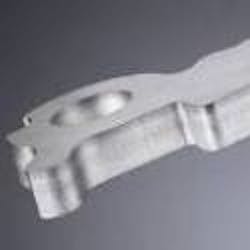Fiber function for laser cutting
Farmington, CT - Solid-state lasers have become increasingly popular, especially for processors looking to cut thin sheet metal. Unfortunately, solid-state lasers' inability to cut heavier-gauge materials with the same quality as their CO2 counterparts has been a drawback for those who need to cut both thick and thin metals. With the development of BrightLine fiber by Trumpf, the CO2 laser no longer has the same advantage.
When Trumpf's latest 2D solid-state laser cutting machines are equipped with this function, they are able to cut thick stainless steel without compromising on the quality of the cut. For example, when the TruLaser 5030 fiber with a 5-kilowatt solid-state laser runs with the BrightLine fiber option, the machine can cut stainless steel even as thick as 1 inch at a cut quality comparable to that of a CO2 laser-equipped machine. (Editor's note: Because BrightLine technology is still in the patent process, the company was unable to offer more detail on how it works for this article.) The technology also produces small holes and tight contours in thick sheet metal, while boosting cut quality and productivity for mild steel between 0.6 and 1 inch. Consequently, this system can cut all the standard types and thicknesses of materials at excellent quality.
BrightLine fiber technology changes the way manufacturers make a decision in regards to laser resonators. Until now, the decision was frequently made by comparing the cut quality of the parts at varying thicknesses and determining the best fit for most jobs. Those who chose to invest in a solid-state laser typically focused on thin sheet and 02 flame cutting. With BrightLine fiber, there is no significant difference in terms of the quality, so the factors that influence this purchase decision can be based on new criteria.
Additional factors come into play, especially where companies have unusual applications or demands. A processor should consider additional features of the machine or laser, such as a function for water-assisted laser cutting. Connection to a laser network where, for instance, a 2D laser cutting machine and a welding cell share a laser source, is possible only with the solid-state laser. The option to perform multiple processing steps with one laser is easily overlooked, yet it may be highly lucrative to the right shop.
The feasibility of the cut must also be explored. A sheet metal part cut from 2-inch stainless steel, for example, is only possible with a CO2 laser, while nonferrous or highly reflective metal can only be cut with a solid-state laser.
The overall economy of a 2D laser system is also influenced by other factors, including various options for automation and software. All the decision-making criteria have to be considered in order to find the ideal system for any given customer. Processors should perform a detailed economic efficiency calculation to determine the true cost of production and should consider their own preferences and experiences with running and maintaining a laser system.
The solid-state laser and the CO2 laser exhibit strengths in different areas, depending on the details of the application. Just as some cars run on gasoline and some on diesel, both solid-state and CO2 lasers will continue to get their users from point A to point B. It's simply a matter of calculating which one does the job the most economically.
